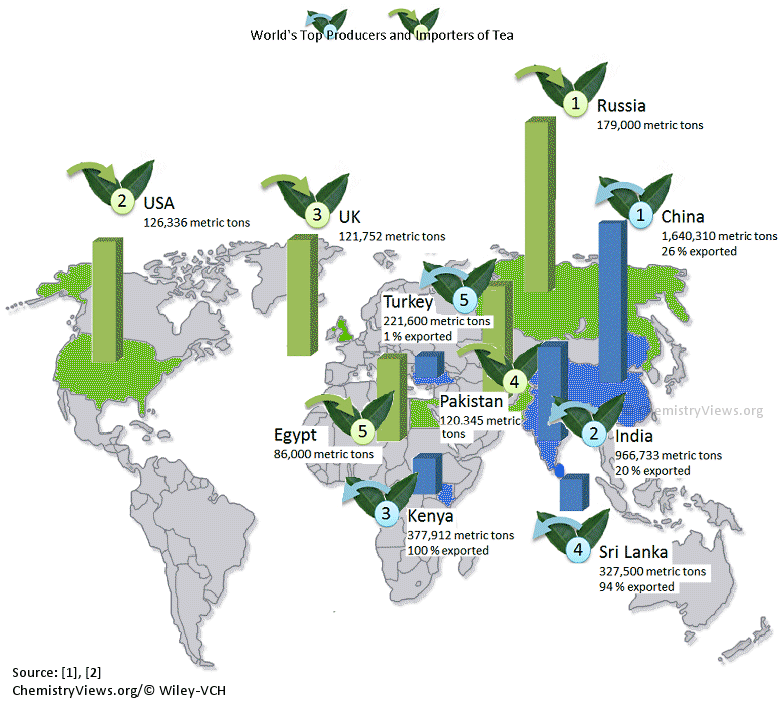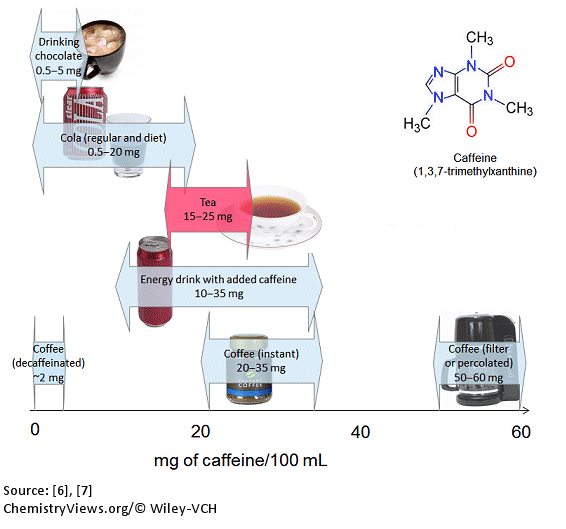Tea is the most widely consumed beverage in the world. Approximately 1,500 varieties are produced from tea grown in 36 countries. Of these, black teas account for 72 % and green teas for 26 %.
Black and green teas come from the same plant and contain similar amounts of flavonoids. These polyphenols are responsible for the flavor of tea and include catechins and their polymeric counterparts, theaflavins and thearubigins. The ratios of the flavonoids differ in black and green teas.
Where Does Tea Come From and Go To?

How do Black and Green Teas Differ?
.gif)
Green tea can gradually change from green to brown if left for a prolonged period. The catechins are slowly oxidized into bisflavanols, theaflavins, epitheaflavic acids, and thearubigens, which are more commonly found in black tea. This is particularly noticable if the tea is kept hot for a long time, for example, in a thermos flask, as the heat speeds the oxidation process.
How Much Caffeine is there in Tea Compare to Other Caffeinated Drinks?

References
[1] Import data: www.faostat.fao.org, 2010, Statistics Division of the Food and Agriculture Organization of the United Nations, Rome, Italy.
[2] Production data: www.faostat.fao.org, 2011, Statistics Division of the Food and Agriculture Organization of the United Nations, Rome, Italy.
[3] Black and Green Tea: How do they differ?, Tea Advisory Panel, London, UK, 2007, February.
[4] Harold N. Graham, Green tea composition, consumption, and polyphenol chemistry, Prev. Med. 1992, 21, 334–350. DOI: 10.1016/0091-7435(92)90041-F
[5] S. Kuhr, U. H. Engelhardt, Determination of flavanols, theogallin, gallic acid and caffeine in tea using HPLC, Z. Lebensm. Unters. Forsch. 1991, 192(6), 526–529. DOI: 10.1007/BF01202507
[6] Survey Of Caffeine And Other Methylxanthines In Energy Drinks And Other Caffeine-Containing Products, Ministry of Agriculture, Fisheries and Food, UK, 1998, March, Number 144. Link
[7] Survey of Caffeine Levels in Hot Beverages, Food Standards Agency, London, UK, 2004, April, Food Information Sheet 53/04. Link (pdf)
Also of Interest
- Espresso – A Three-Step Preparation,
Klaus Roth,
ChemistryViews 2010.
DOI: 10.1002/chemv.201000003
Klaus Roth proves that no culinary masterpiece can be achieved without a basic knowledge of chemistry. - A. Crocker, Tea in Ullmann’s Encyclopedia of Industrial Chemistry,
Vol. 17, Wiley-VCH, Weinheim, Germany, 2006, pp. 679–684.
DOI: 10.1002/14356007.a26_171




